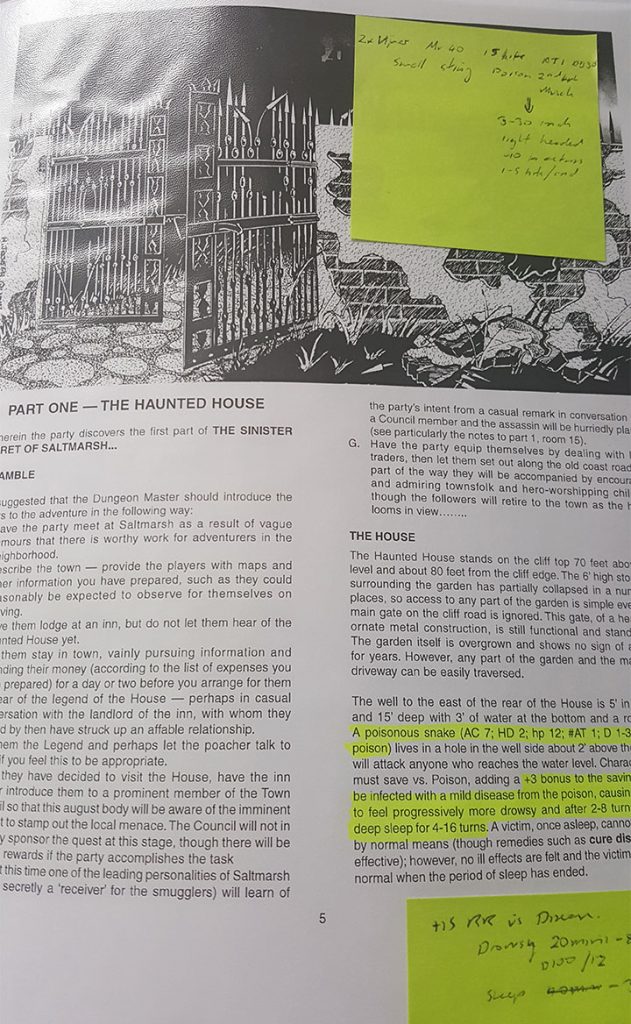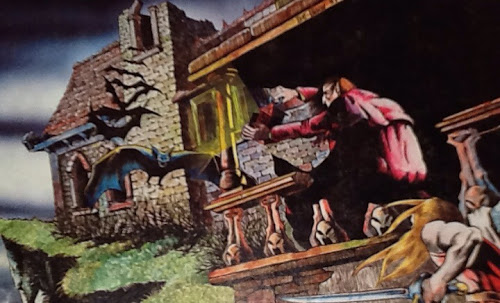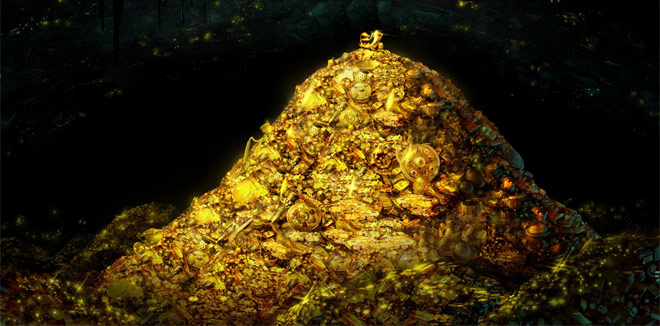Following Brian’s suggestion I have taken the haunted house from The Sinister Secret of Saltmarsh as the basis of my haunted house. We are going to play this on the 16th so it is time to finalise my prep.
You can see, but probably not read my hand writing, that I am doing my usual sprinkling of post-it notes.

Noting the Encounters
The top post-it has just enough details for me to run an encounter with the snake(s). The original module had just a single poisonous snake at this point but I have swapped that out and made it a pair of vipers. The note reads 2x Vipers and then just enough details from Creatures and Treasures, the level, Mv, hits, AT, DB and OB etc. The block handing down below are the details of the poison taken from Character Law about the type and effect of the poison.
In this way I have saved myself two book look ups just by copying the core details onto the page. From a prepping point of view it takes very little time to write out just a single note so I can do a page or two each time I take a tea break.
Keeping track of Experience
The other thing that is popular is the game journal. We play so infrequently that the chances of remembering every step or clue in the game from one session to the next is almost nil. By taking my post-its off the page when they are finished with, the combat done or the NPC encountered. I can move them to where I keep my journal notes. I also use that for experience; so the details of the fight or however the vipers in this case were circumvented goes with the note into the journal.
As I am converting from one system to another there are a lot of changes to make to a bought module such as this but no more than if I was writing an adventure myself. The point is that I cam looking up the rules that will be called into play now rather than at the gaming table.
What to convert?
The sort of things I have noting are:
- Converting D&D Potions into Rolemaster Herbs where possible.
- Converting Monsters over to Rolemaster creatures if they exist, if not I am doing a manual conversion.
- Creating NPCs as RM characters.
- Checking and inserting the rules for poisons, diseases and traps.
- Setting difficulty factors for traps, locks and manoeuvres.
- Converting money from D&D to the Rolemaster decimal system.
Funnily enough it is the conversion of the magical items into RM herbs or into RM spell effects that makes the biggest difference to the feel of the game. D&D just does not have the herb culture and being able to smoothly integrate the herbs into the setting where they did not exist before works well. Conversely Rolemaster does not have a potion culture like D&D so by toning the use of poisons down helps.
In the current adventure there is a ring of protection +1 to be had fairly easily. We all know these from our D&D backgrounds but again they are not a Rolemaster ‘thing’. In the game as it will be played it will be a Ring (Daily III item casting Blur). They are not exactly the same but the trade off is that the ring of protection is a constant effect item that would give +5DB but I am giving away a +10DB but can only be used three times a day for short periods.
It is little tweaks like this that make the module feel like it is native Rolemaster rather than converted D&D.
It is the potted rule lookups on the page where they are needed that save time at the table.
The monster stats on the page with any special rules to run them that helps speed up combat. As I have said before for NPCs I note down the general plan for the first three rounds of combat and if or not they would try to escape and how.
Keeping it Sinister
Finally I have one other type of post-it on these pages. I am using them to remind me to lay on the atmosphere. This is meant to be a haunted house. With all the ideas I have to use from the 100 Creepy things books (http://www.rolemasterblog.com/azukail-games-100-creepy-things-events-encounter-outdoors/ ) I want to lay on the spooky effects. This is not intended to be a dungeon crawl and these little reminders are there to reinforce that point.



